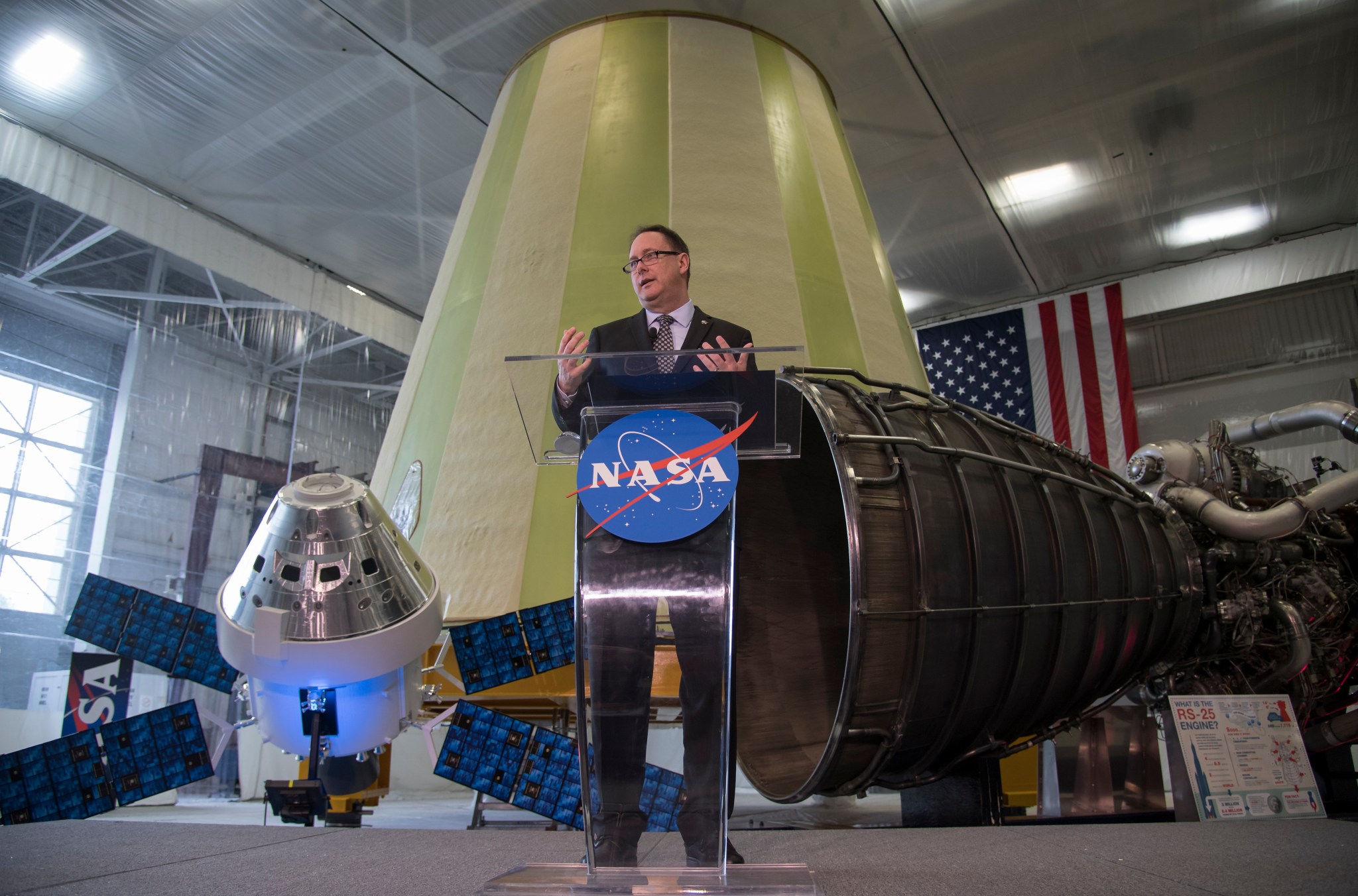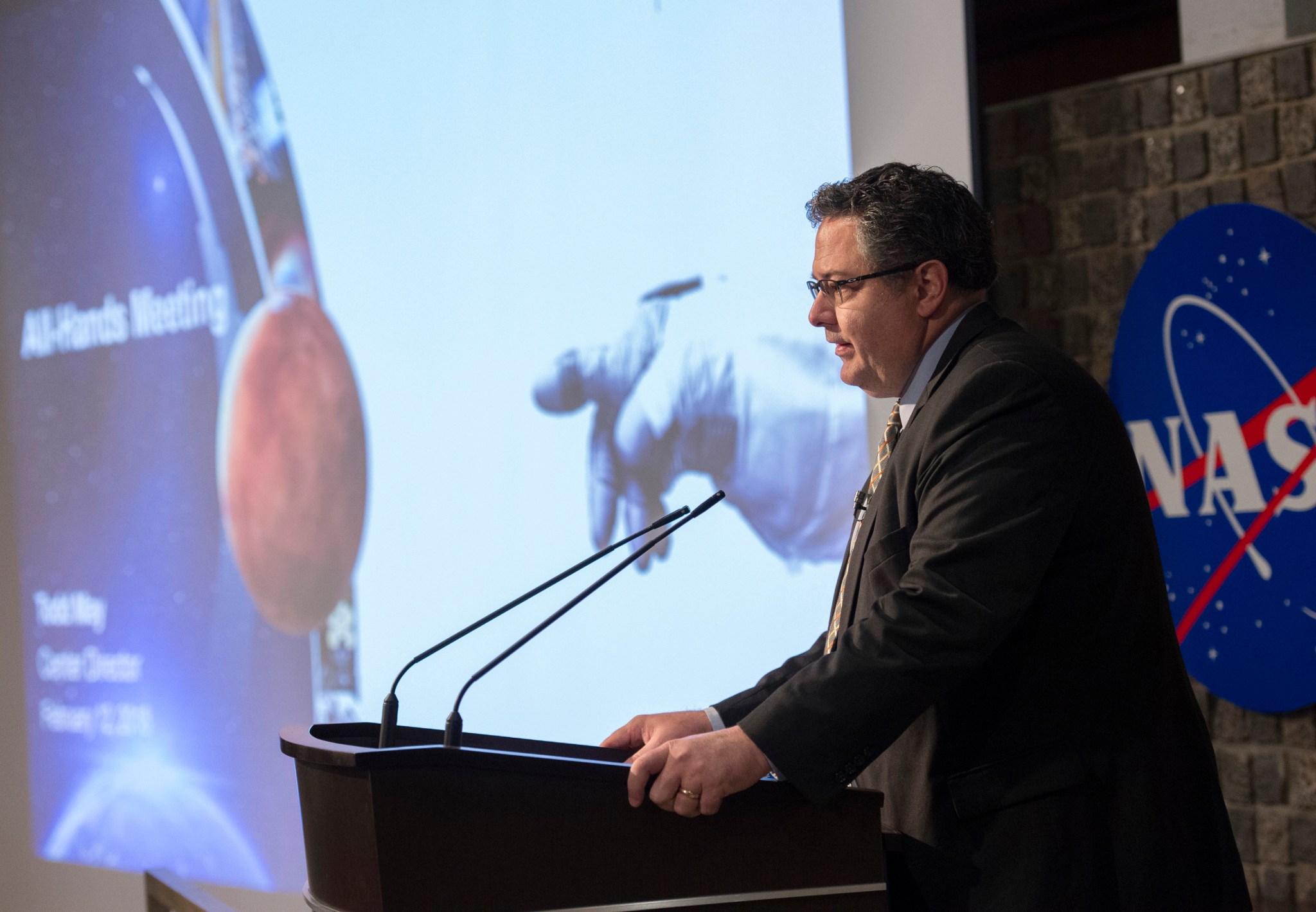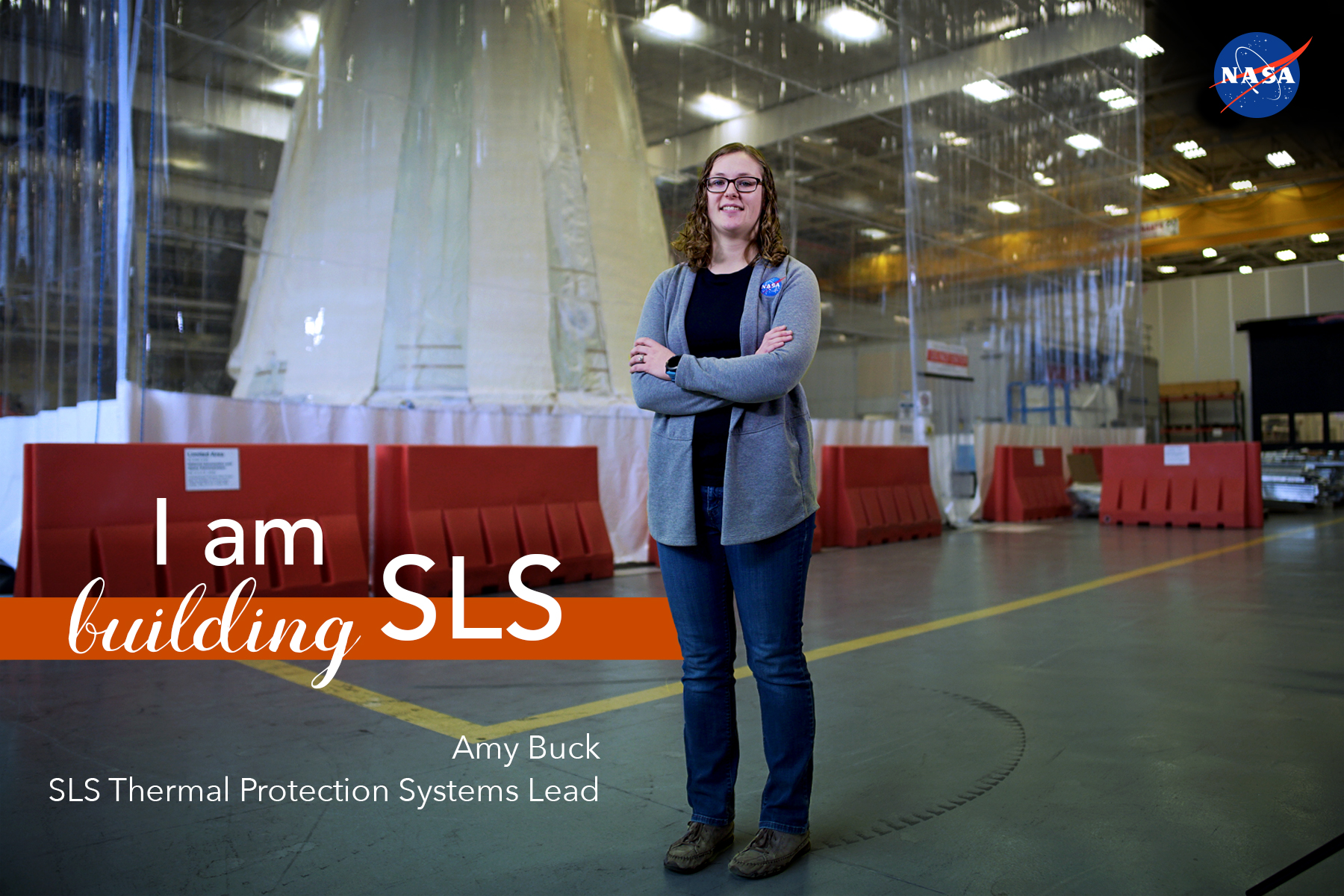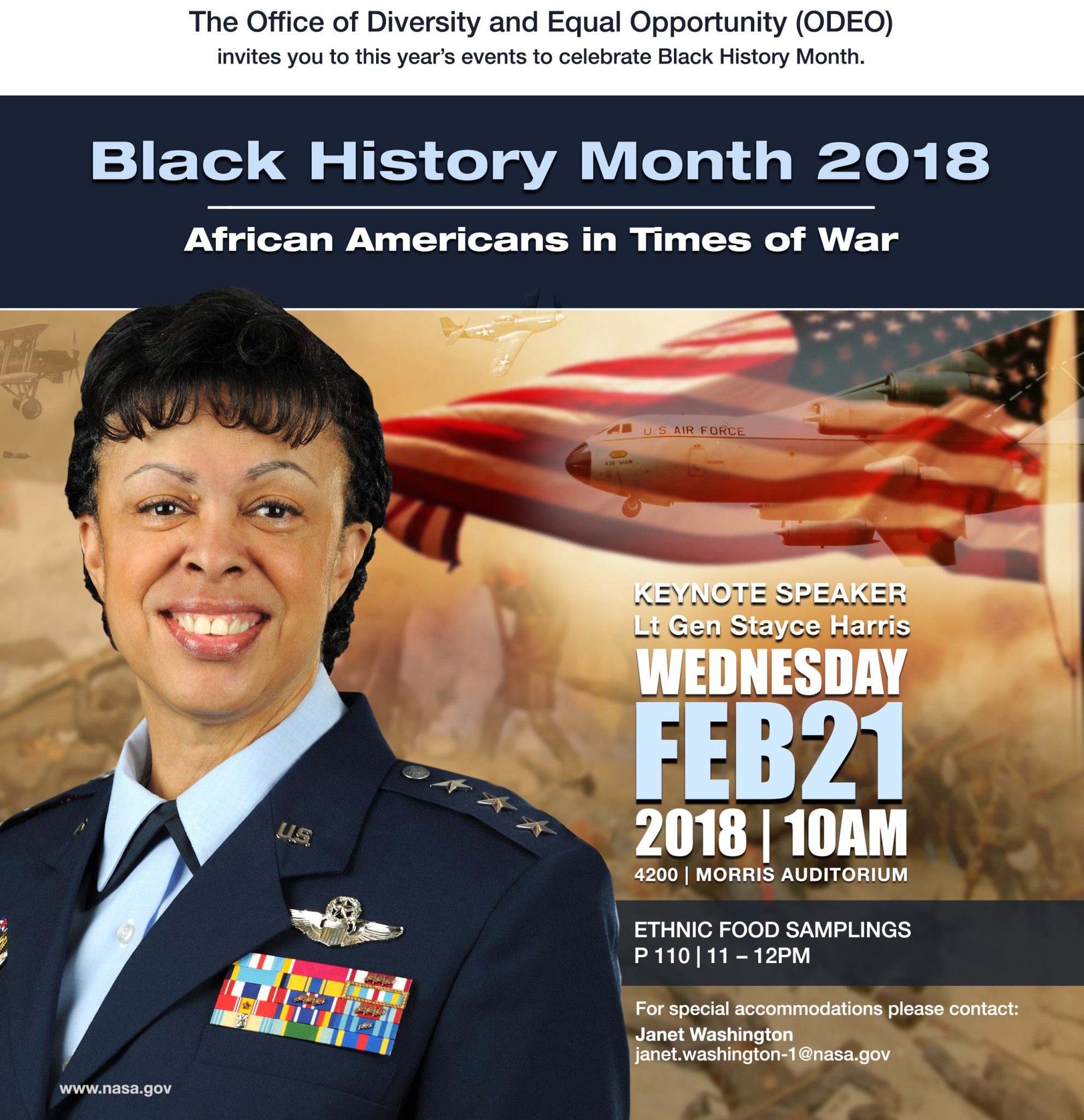In This Week’s Star
- NASA Acting Administrator Robert Lightfoot Delivers ‘State of NASA’ from Marshall
- Center Director Todd May Believes Budget Request Will Help Marshall ‘Turn Dreams into Historic Achievements’
- I Am Building SLS: Amy Buck
- Winter ‘AstrOlympics’ Blends Science and Sports
- Marshall to Commemorate Black History Month at Feb. 21 Event
- Progress Cargo Craft Launches on Two-Day Trip to Space Station
- Marshall’s Martin Weisskopf Speaks at National Space Club Breakfast
- This Week in NASA History: STS-41B Lands – Feb. 11, 1984
- Obituaries
NASA Acting Administrator Robert Lightfoot Delivers ‘State of NASA’ from Marshall
NASA Acting Administrator Robert Lightfoot delivers the “State of NASA” Feb. 12 at the Marshall Space Flight Center. Lightfoot discussed what the President’s Fiscal Year 2019 budget request means for America’s space agency. It “reflects the administration’s confidence that America will lead the way back to the Moon and take the next giant leap,” Lightfoot said. He delivered the address at Marshall’s Center for Advanced Manufacturing, where engineers are pushing boundaries in the fields of additive manufacturing, 3-D printing and more. Hardware for NASA’s Space Launch System and a model of the agency’s Orion spacecraft served as a backdrop for the event. SLS, managed by Marshall, will enable a new era of exploration beyond Earth’s orbit by launching astronauts on missions to deep-space destinations including the Moon and Mars. To view Lightfoot’s address, click here. (NASA/Bill Ingalls)
Center Director Todd May Believes Budget Request Will Help Marshall ‘Turn Dreams into Historic Achievements’
By Brian C. Massey
Following NASA Acting Administrator Robert Lightfoot’s “State of NASA” address, in response to President Donald Trump’s fiscal year 2019 budget proposal to the U.S. Congress on Feb. 12, Marshall Space Flight Center Director Todd May held an all-hands meeting with the workforce to discuss the administration’s budget request in relation to the center and its programs and mission.
The president’s $19.9 billion request for NASA, including a $2.8 billion request for Marshall, is a very positive budget for Marshall and the agency, according to May, giving the center the resources needed to deliver on its commitments.
“At Marshall, we are paving the way for a new era of space exploration and science, and this budget keeps us in business today, while setting the stage for an even bigger future,” he said.
With the requested budget, work at Marshall will continue on the Space Launch System, International Space Station, state-of-the-art propulsion architecture and systems for deep-space exploration, science and much more.
“We will continue to build, test and integrate all the elements of SLS and the Orion spacecraft — moving closer to that historic moment when the rocket launches on its first mission,” May continued. “Ultimately, we are doing the critical work needed to lead our nation’s return to bold, world-changing exploration missions that put the Moon, Mars and beyond in reach of humankind.”
The positive budget request for Marshall and the agency are a direct result of Congress and the president’s strong support and belief in the greater purpose of America’s space exploration missions, according to May.
“The bottom line is that Marshall enjoys strong support because our team members make it easy — giving life to great ideas and turning dreams into historic achievements,” he said. “We have the people and the plan in place to tackle any challenges that lie ahead and to make the most of the opportunities that come our way.”
To view May’s all-hands meeting, click here.
For more information about the NASA fiscal year 2019 budget proposal, click here.
Massey, an ASRC Federal/Analytical Services employee, supports the Office of Strategic Analysis & Communications.
I Am Building SLS: Amy Buck
This engineer is fulfilling a childhood dream of working for NASA on the agency’s new heavy-lift rocket, the Space Launch System. Meet Amy Buck, an SLS Thermal Protection Systems Lead at NASA’s Marshall Space Flight Center.
I’ve wanted to work for NASA since I went to space camp at the U.S. Space & Rocket Center in Huntsville when I was in fifth grade. Now, I’m living my dream and working on the Space Launch System at Marshall. I lead the team that applies thermal protection systems to the largest piece of hardware built at Marshall — the launch vehicle stage adapter — to ensure it doesn’t get too hot or too cold during flight. I also work on the team that developed the foam protection for the entire rocket.
I grew up in the small town of Cabot, Arkansas, where there are no aerospace jobs. When I was looking for schools, I found Auburn University in Alabama and fell in love with the engineering program. I interned with NASA and knew this is where I wanted to work. I earned an undergraduate degree in aerospace engineering followed by a master’s degree in materials engineering, and I got hired soon after graduation in 2014.
At 28 years old, I’m the youngest person on the team I lead, which is sometimes challenging, but I love knowing that what we are working on every day will end up in space. One of my greatest accomplishments so far is being a part of the team designing a solution for SLS testing. The heat from green run testing, the final test before flight, would have burned off the thermal protection system cork on the engine section. Instead of foam, cork insulates the engine section because higher temperatures exist near the engines that put out 2 million pounds of thrust, but even cork can’t survive both testing and flight. My team developed a barrier to reflect the heat and protect the cork so it can survive green run testing and a subsequent flight. This saved the SLS Program both time and money.
When I’m not working on NASA’s new rocket, you can find me with my husband working on our farm where we raise goats and chickens and keep bees. I’m an avid runner and conquered my first marathon last year. It was one of the hardest things I’ve ever done, but finishing the race gave me such a sense of accomplishment. I think playing a part in the completion of the SLS rocket and seeing it fly will be like crossing the finish line of a marathon.
Winter ‘AstrOlympics’ Blends Science and Sports
An innovative communications project from NASA’s Chandra X-ray Observatory program puts a new spin on the Winter Olympics underway in Pyeongchang, South Korea. Developed by Chandra’s communications team, the “AstrOlympics” project highlights the physics of sport and space.
AstrOlympics is a series of posters and videos that connect the amazing feats of Olympic athletes to spectacular phenomena found in space. Marshall team members will have an opportunity to view the AstrOlympics poster display in Building 4203 during the 2018 Winter Olympic Games and Paralympic Games, Feb. 9-25 and March 9-18, respectively.
The unique materials explain physical concepts like speed, mass and rotation using examples from everyday life, Olympic events and scientific discoveries made with Chandra and other observatories. For example, the rotation section compares the spin of an ice skater to that of a washing machine to the rotating of a spinning dead star.
All the products are available for free download from Chandra’s AstrOlympics website.
Marshall to Commemorate Black History Month at Feb. 21 Event
NASA’s Marshall Space Flight Center will observe Black History Month with an event featuring Lt. Gen. Stayce Harris, Inspector General of the U.S. Air Force.
Marshall team members are encouraged to attend the event in Morris Auditorium on Feb. 21 at 10 a.m., where Harris will speak about “African Americans in Times of War,” focusing on the crucial role of African American contributions in the armed services. She will discuss her past experiences, current professional practices and future aspirations for African Americans studying science, technology, engineering and mathematics disciplines.
Harris reports to the Secretary and Chief of Staff of the Air Force in Washington, where she is responsible for the Air Force Inspection Agency and the Air Force Office of Special Investigations.
Following the program, a food sampling will be served in Building 4200, room P110, from 11 a.m.- noon.
The event is sponsored and organized by the Office of Diversity and Equal Opportunity. For more information or special accommodations, please contact Janet Washington.
Progress Cargo Craft Launches on Two-Day Trip to Space Station
Carrying more than 3 tons of food, fuel and supplies for the International Space Station Expedition 54 crew, the Progress 69 cargo spacecraft launched at 2:13 a.m. CST, Feb. 11, from the Baikonur Cosmodrome in Kazakhstan.
At the time of launch, the space station was flying over the South Atlantic Ocean, north of the Falkland Islands at an altitude of 252 miles. Less than 10 minutes after launch, the resupply ship reached preliminary orbit and deployed its solar arrays and navigational antennas as planned.
The Progress 69 cargo vehicle will dock automatically to the aft port of the Zvezda service module of the station at 4:43 a.m. Feb. 15. Watch live coverage beginning at 4 a.m. on NASA Television and the agency’s website. The Progress spacecraft will remain at the orbiting laboratory until late August.
Marshall’s Martin Weisskopf Speaks at National Space Club Breakfast
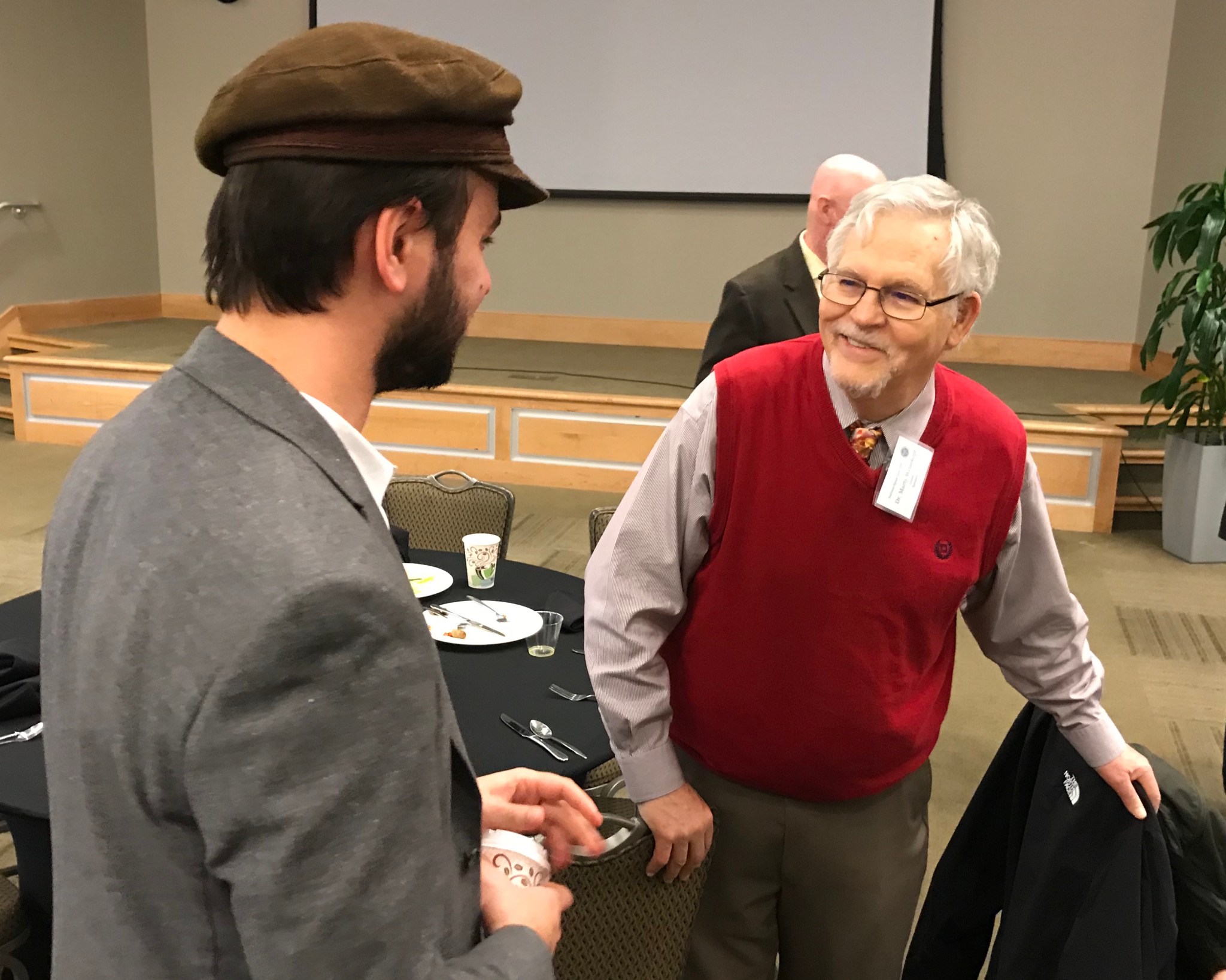
Martin Weisskopf, right, the project scientist for NASA’s Chandra X-ray Observatory and chief scientist for X-ray astronomy in the Astrophysics Branch at NASA’s Marshall Space Flight Center, greets a member of the audience following Weisskopf‘s speech Feb. 13 at National Space Club Huntsville’s monthly breakfast. Weisskopf discussed “X-Ray Astronomy at Marshall: Past, Present and Future.” The discussion centered around Chandra, which allows scientists from around the world to obtain X-ray images of exotic environments to help understand the structure and evolution of the universe. “X-Ray astronomy is intimately tied to the space program and with Marshall,” Weisskopf said. For the next Space Club breakfast on March 20, the speaker will be NASA Acting Director Robert Lightfoot. The organization’s mission is to promote the awareness of civilian and military applications for rocketry and astronautics. Participation in its events helps raise money for scholarships and STEM engagement in the community. To learn more about the club, click here. (Jonathan Deal/NASA/MSFC)
This Week in NASA History: STS-41B Lands – Feb. 11, 1984
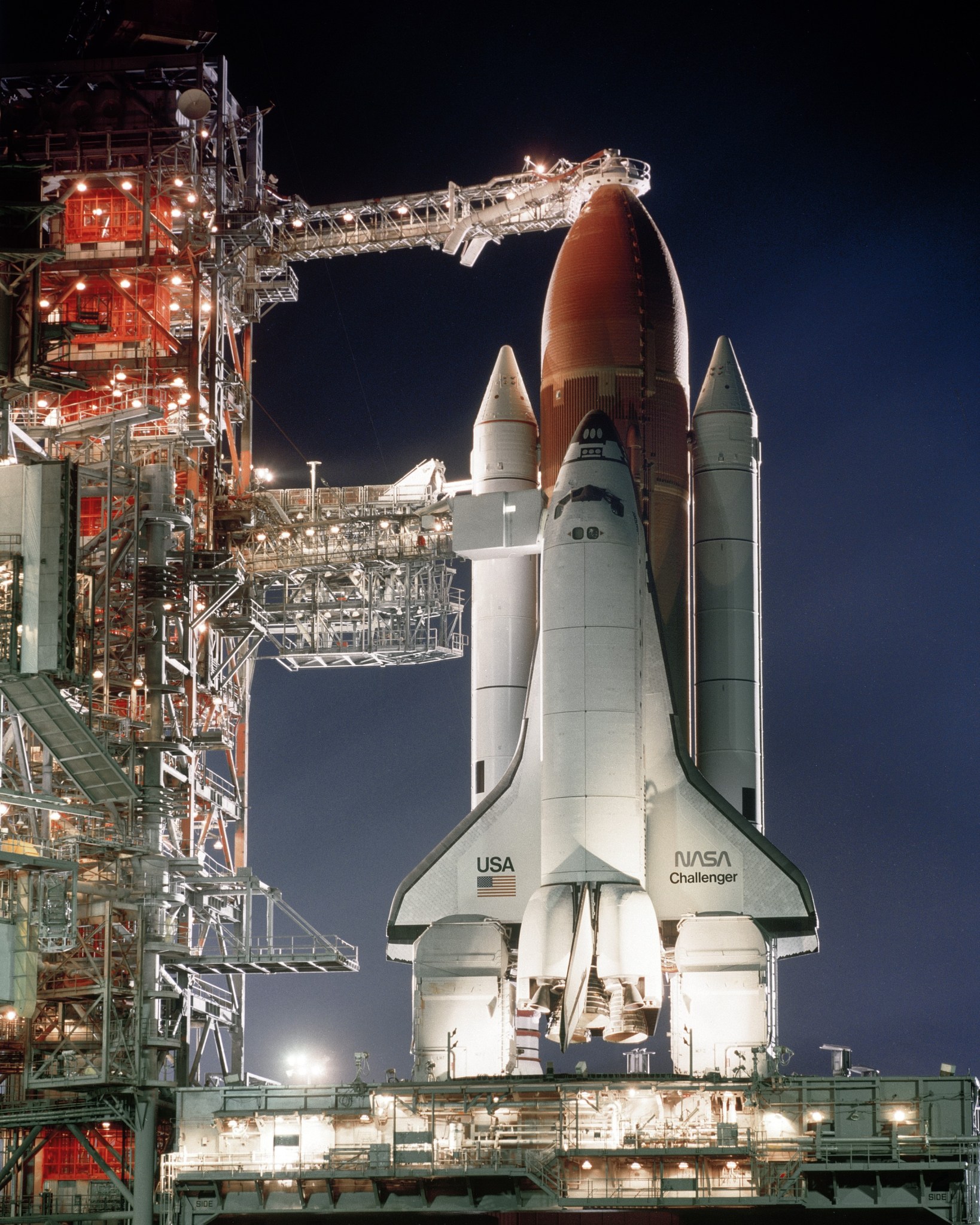
This week in 1984, the space shuttle Challenger, mission STS-41B, landed safely at NASA’s Kennedy Space Center following a successful seven-day mission. This was the first shuttle landing at Kennedy. STS-41B is also known for the first untethered spacewalk using the manned maneuvering unit by former NASA astronaut Bruce McCandless. Here, Challenger awaits launch on pad 39A at Kennedy. Today, the Payload Operations Integration Center at NASA’s Marshall Space Flight Center serves as “science central” for the International Space Station, working 24/7, 365 days a year in support of the orbiting laboratory’s scientific experiments. The NASA History Program is responsible for generating, disseminating and preserving NASA’s remarkable history and providing a comprehensive understanding of the institutional, cultural, social, political, economic, technological and scientific aspects of NASA’s activities in aeronautics and space. For more pictures like this one and to connect to NASA’s history, visit the Marshall History Program’s webpage. (NASA)
Obituaries
Charles H. Jackson, 81, of Decatur, Alabama, died Feb. 12. He retired from the Marshall Center in 1994 as a materials engineer. He is survived by his wife, Judith K. Jackson.
Maurice C. Willis, 89, of Falkville, Alabama, died Feb. 8. He retired from the Marshall Center in 1979 as an engineer.
Thomas A. Barr, of Huntsville, died Feb. 7. He retired from the Marshall Center in 1981 as an aerospace engineer. He survived by his wife, Jane Barr.

























